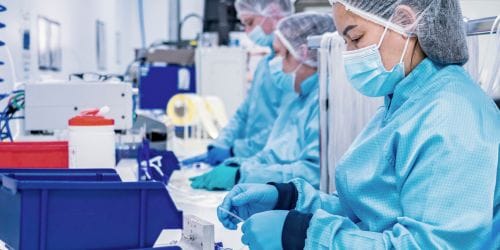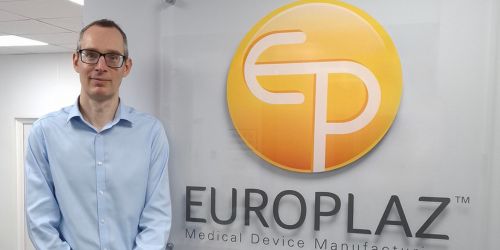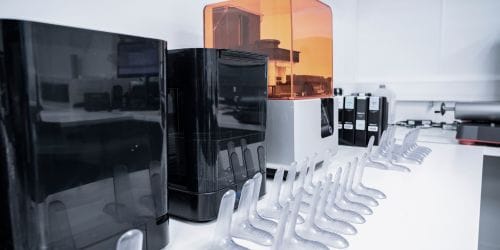In medical device development, plastics are a popular material, thanks to their versatility, costs, and production speed. The plastics used vary greatly, depending on the purpose and system and each comes with its own set of benefits and applications.
With such a long list, understanding the different types of plastics used in medical devices, and their applications, can go a long way to helping you learn how the process works and what types of projects we can help you with.
That’s where we can help. From design and prototyping to scaling up production for products already approved by medical bodies, our team at Europlaz understands every step of the process and can assist with your next medical device production and rollout. Join us as we take a look at the applications, as well as the benefits, of plastics in medical devices.
Contents:
1. Types of plastics used in injection moulding
2. Advantages of plastics in medical applications
3. Plastics used in single-use medical devices
4. Plastics used in regular-use medical devices
5. Medical device development
The plastics used in injection moulding for medical devices
In the realm of medical devices, plastics are chosen based on their biocompatibility, chemical resistance, physical properties, and the ability to be sterilised without compromising material integrity. These properties make them perfect for medical device injection moulding and for application in either single-use devices or regular-use devices.
What are the advantages of plastics in medical applications?
This selection of plastics for medical devices depends on regulatory requirements, intended use, biocompatibility testing, sterilisation needs, and other factors. However, even with this in mind, most plastics offer common advantages including:
Biocompatibility: Many plastics used in medical devices are biocompatible, meaning they have minimal adverse effects on living tissue and can be safely used in contact with the human body.
Sterilisation Compatibility: Plastics selected for medical devices often withstand various sterilisation methods, such as steam, ethylene oxide gas, radiation, or chemical processes. This reduces the chance of contamination and gives you peace of mind in bringing products to patients.
Transparency and Clarity: Plastics offer excellent transparency, enabling easy visualisation of contents or indicators on medical devices. This clarity is incredibly important in testing as well as measuring quantities of medicines.
Chemical Resistance: Plastics used in medical devices are often resistant to chemicals, ensuring compatibility with medications, disinfectants, and cleaning agents. This makes it easier to reuse medical devices and eliminates risks around corrosion or wear and tear.
Mechanical Properties: Different plastics possess unique mechanical properties like flexibility, impact resistance, strength, or dimensional stability, which are crucial for their specific applications. This is especially valuable in the production process where millimetre perfect measurements and bespoke plastic parts are needed.
These properties can be found in varying degrees and lead to important decisions around the materials used that are best for manufacturing as well as application. Here are some of the plastics used in single-use and regular-use medical devices.
Single-use medical devices
Single-use devices are common in a wide range of applications and settings. From testing at home to administering medication in a single dose, the plastics used in these devices need to be hardwearing and reliable.
To ensure a uniform product across thousands of devices and a robust structure, we use a select group of plastics for medical device development. But, what plastics are used in medical injection moulding?
Polystyrene (PS): Polystyrene is lightweight, rigid, and has excellent clarity. It is easily moulded and offers good dimensional stability. It is also resistant to moisture and chemical substances and non-toxic, making it suitable for various medical device applications.
PS is commonly used in disposable medical instruments, Petri dishes and diagnostic components.
Polyoxymethylene (POM): POM, also known as acetal, offers high strength, excellent dimensional stability, and low friction properties. This provides this material with good wear as well as good resistance to chemicals and moisture.
POM is often used for precision parts in devices such as insulin pens, inhalers, and surgical instruments.
Polypropylene (PP): Polypropylene is a lightweight and durable plastic with excellent chemical resistance. Produced as PPh (HomoPolypropylene) and PPc (CoPolypropylene), this plastic offers good fatigue resistance and can withstand repeated sterilisation cycles. PP is also known for its low moisture absorption and high impact strength.
PPh and PPc are widely used in medical devices such as syringes, containers, and non-woven fabrics.
Thermoplastic Elastomer (TPE): TPE is a versatile material that combines the characteristics of rubber and plastic. It offers excellent flexibility, elasticity, and softness. TPE encompasses TPU, TPV, TPS, SEBS and SBS, and can be easily processed and has good resistance to chemicals, oils, and UV radiation. It also provides a comfortable and secure grip.
These properties make TPE ideal for medical device grips, seals, gaskets and tubing.
Ethylene-vinyl acetate (EVA): also known as acetal plastic, EVA is soft, flexible, transparent, and has good barrier protection. This makes it and important material for delivery systems and components.
Due to its soft, flexible nature, EVA is used predominantly in tubing, drug delivery systems, and IV components.
Polyamide (PA) Nylon: Polyamide (PA) nylon is a strong and durable plastic that is resistant to wear and abrasion and has good thermal and chemical resistance. This chemical resistance makes PA nylon great for repeated sterilisation cycles.
PA nylon is commonly used for medical device components and devices such as sutures, surgical instruments, and medical tubing.
Co-Polyester: Co-Polyester, also known as Polyethylene terephthalate (PETG), is a widely used plastic in medical device development. It offers several strengths that make it suitable for various applications in healthcare. This includes exceptional clarity, chemical resistance, and toughness making it ideal for visual inspection devices.
Co-Polyester is commonly used in medical films, tubing, and containers such as syringes and blood collection tubes.
Regular-use medical devices
Regular-use devices such as inhalers need to be robust enough to withstand regular use. As such, the plastics used are often tough and can be made in conjunction with other materials. This process includes medical device plastic injection moulding practises and includes materials such as:
Polycarbonate (PC): Polycarbonate is a clear, impact-resistant plastic with high heat resistance. It exhibits excellent dimensional stability and can be moulded into complex shapes. PC is also temperature resistant making it versatile for a range of devices.
PC is commonly used for medical device housings, surgical instruments, incubators, and patient contact devices.
Acrylonitrile Butadiene Styrene (ABS): ABS is a versatile plastic known for its good impact resistance, strength, and dimensional stability. It is also relatively lightweight and can easily be moulded.
ABS is commonly used for housings for medical devices, medical equipment enclosures, drug delivery devices, and other components that require strength, impact resistance, and ease of processing.
Polysulfone (PSU): Polysulfone offers excellent thermal stability, high strength, and good chemical resistance. These properties allow PSU to withstand elevated temperatures without losing its mechanical properties. It is also resistant to disinfectant making it easy to maintain.
PSU is commonly used for sterilisation trays, dialysis equipment, blood oxygenators, and sterile filtration.
Polyethylene: Ranging from flexible (LDPE) to rigid (HDPE) to extremely wear-resistant (UHMWPE), this family of plastics offers a wide range of strengths including wear resistance, flexibility, and long-term rigidity, depending on the application and need.
This varied group means this plastic has a wide range of applications including surgical instruments, orthopaedic implants, and prosthetics.
Europlaz: leaders in medical device development
As you can see there are a wide variety of plastics that can be used for single and regular use medical devices. However, choosing the right material requires expertise in regulatory requirements, intended use, biocompatibility testing, and sterilisation needs. As such, it’s important to work with a manufacturer that has experience with all facets of the device development process. That’s where we can help.
For more than 40 years, our team has provided design, engineering and manufacturing expertise for the medical device industry. During this time we have worked on a variety of projects from inhalers to single-use tests and specialise in Class I and Class II devices.
We offer insight and guidance every step of the way, so you know the answer to every question, be it what plastics are used in medical injection moulding? Or how many products can be manufactured in a day? For more information, contact us today to learn about the materials we can work with and how we can bring your next project to life.





